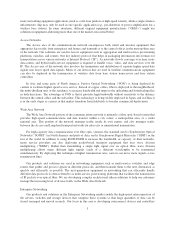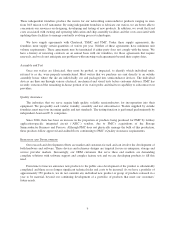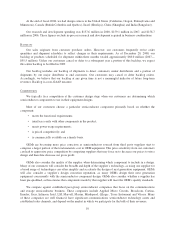Adaptec 2008 Annual Report Download - page 15
Download and view the complete annual report
Please find page 15 of the 2008 Adaptec annual report below. You can navigate through the pages in the report by either clicking on the pages listed below, or by using the keyword search tool below to find specific information within the annual report.On an on-going basis, some of our Israeli employees are periodically called into active military duty. In the
event of severe hostilities breaking out, a significant number of our Israeli employees may be called into active
military duty, resulting in delays in various aspects of production, including product development schedules.
Our revenues may decline if we do not maintain a competitive portfolio of products.
We are experiencing significantly greater competition in the markets in which we participate. We are
expanding into markets, such as the Enterprise Networking and Access Networks markets, which may have
established incumbents with substantial financial and technological resources. We expect more intense
competition than that which we have traditionally faced as some of these incumbents derive a majority of their
earnings from these markets.
We typically face competition at the design stage, where customers evaluate alternative design approaches
requiring integrated circuits. The markets for our products are intensely competitive and subject to rapid
technological advancement in design tools, wafer manufacturing techniques, process tools and alternate
networking technologies. We may not be able to develop new products at competitive pricing and performance
levels. Even if we are able to do so, we may not complete a new product and introduce it to market in a timely
manner. Our customers may substitute use of our products in their next generation equipment with those of
current or future competitors, reducing our future revenues. With the shortening product life and design-in cycles
in many of our customers’ products, our competitors may have more opportunities to supplant our products in
next generation systems.
Our customers are increasingly price conscious, as semiconductors sourced from third party suppliers
comprise a greater portion of the total materials cost in networking equipment. We continue to experience
aggressive price competition from competitors that wish to enter into the market segments in which we
participate. These circumstances may make some of our products less competitive, and we may be forced to
decrease our prices significantly to win a design. We may lose design opportunities or may experience overall
declines in gross margins as a result of increased price competition.
Over the next few years, we expect additional competitors, some of which may also have greater financial
and other resources, to enter these markets with new products. These companies, individually or collectively,
could represent future competition for many design wins, and subsequent product sales.
Design wins do not translate into near-term revenues and the timing of revenues from newly designed
products is often uncertain.
From time to time, we announce new products and design wins for existing and new products. While some
industry analysts may use design wins as a metric for future revenues, many design wins have not, and will not,
generate any revenues for us, as customer projects are cancelled or unsuccessful in their end market. In the event
a design win generates revenues, the amount of revenues will vary greatly from one design win to another. In
addition, most revenue-generating design wins do not translate into near-term revenues. Most revenue-generating
design wins take more than two years to generate meaningful revenues.
We may be unsuccessful in transitioning the design of our new products to new manufacturing processes.
Many of our new products are designed to take advantage of new manufacturing processes offering smaller
device geometries as they become available, since smaller geometries can provide a product with improved
features such as lower power requirements, increased performance, more functionality and lower cost. We
believe that the transition of our products to, and introduction of new products using, smaller device geometries
is critical for us to remain competitive. We could experience difficulties in migrating to future smaller device
geometries or manufacturing processes, which would result in the delay of the production of our products. Our
products may become obsolete during these delays, or allow competitors’ parts to be chosen by customers during
the design process.
15
























